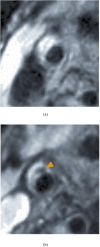Advances in MRI for the evaluation of carotid atherosclerosis
- PMID: 25826233
- PMCID: PMC4651390
- DOI: 10.1259/bjr.20140282
Advances in MRI for the evaluation of carotid atherosclerosis
Abstract
Carotid artery atherosclerosis is an important source of mortality and morbidity in the Western world with significant socioeconomic implications. The quest for the early identification of the vulnerable carotid plaque is already in its third decade and traditional measures, such as the sonographic degree of stenosis, are not selective enough to distinguish those who would really benefit from a carotid endarterectomy. MRI of the carotid plaque enables the visualization of plaque composition and specific plaque components that have been linked to a higher risk of subsequent embolic events. Blood suppressed T1 and T2 weighted and proton density-weighted fast spin echo, gradient echo and time-of-flight sequences are typically used to quantify plaque components such as lipid-rich necrotic core, intraplaque haemorrhage, calcification and surface defects including erosion, disruption and ulceration. The purpose of this article is to review the most important recent advances in MRI technology to enable better diagnostic carotid imaging.
Figures





Similar articles
-
Contemporary carotid imaging: from degree of stenosis to plaque vulnerability.J Neurosurg. 2016 Jan;124(1):27-42. doi: 10.3171/2015.1.JNS142452. Epub 2015 Jul 31. J Neurosurg. 2016. PMID: 26230478 Review.
-
Validity of dual MRI and F-FDG PET imaging in predicting vulnerable and inflamed carotid plaque.Cerebrovasc Dis. 2013;35(4):370-7. doi: 10.1159/000348846. Epub 2013 Apr 30. Cerebrovasc Dis. 2013. PMID: 23635390
-
Histological validation of three-dimensional variable flip angle turbo spin echo multi-contrast magnetic resonance vessel wall imaging in characterizing carotid vulnerable atherosclerotic plaques.J Cardiovasc Magn Reson. 2024 Winter;26(2):101112. doi: 10.1016/j.jocmr.2024.101112. Epub 2024 Oct 22. J Cardiovasc Magn Reson. 2024. PMID: 39442673 Free PMC article.
-
Hemorrhage in the atherosclerotic carotid plaque: a high-resolution MRI study.Stroke. 2004 May;35(5):1079-84. doi: 10.1161/01.STR.0000125856.25309.86. Epub 2004 Apr 1. Stroke. 2004. PMID: 15060318
-
Advanced MRI for carotid plaque imaging.Int J Cardiovasc Imaging. 2016 Jan;32(1):83-9. doi: 10.1007/s10554-015-0743-6. Epub 2015 Aug 21. Int J Cardiovasc Imaging. 2016. PMID: 26293362 Free PMC article. Review.
Cited by
-
Modifiable Factors Leading to Increased Length of Stay after Carotid Endarterectomy.Ann Vasc Surg. 2017 Feb;39:195-203. doi: 10.1016/j.avsg.2016.05.126. Epub 2016 Aug 20. Ann Vasc Surg. 2017. PMID: 27554691 Free PMC article.
-
Survival intravascular photoacoustic imaging of lipid-rich plaque in cholesterol fed rabbits.Transl Biophotonics. 2022 Dec;4(4):e202200012. doi: 10.1002/tbio.202200012. Epub 2022 Sep 4. Transl Biophotonics. 2022. PMID: 38283396 Free PMC article.
-
Stress-Relaxation and Cyclic Behavior of Human Carotid Plaque Tissue.Front Bioeng Biotechnol. 2020 Feb 11;8:60. doi: 10.3389/fbioe.2020.00060. eCollection 2020. Front Bioeng Biotechnol. 2020. PMID: 32117939 Free PMC article.
-
CT-pathologic correlation of non-calcified atherosclerotic arterial plaques: a study using carotid endarterectomy specimens.Br J Radiol. 2020 May 1;93(1109):20190901. doi: 10.1259/bjr.20190901. Epub 2020 Feb 7. Br J Radiol. 2020. PMID: 31999208 Free PMC article.
-
Noninvasive Imaging to Assess Atherosclerotic Plaque Composition and Disease Activity: Coronary and Carotid Applications.JACC Cardiovasc Imaging. 2020 Apr;13(4):1055-1068. doi: 10.1016/j.jcmg.2019.03.033. Epub 2019 Aug 14. JACC Cardiovasc Imaging. 2020. PMID: 31422147 Free PMC article. Review.
References
-
- Roger VL, Go AS, Lloyd-Jones DM, Adams RJ, Berry JD, Brown TM, et al. ; American Heart Association Statistics Committee and Stroke Statistics Subcommittee. Heart disease and stroke statistics—2011 update: a report from the American Heart Association. Circulation 2011; 123: e18–209. doi: 10.1161/CIR.0b013e3182009701 - DOI - PMC - PubMed
-
- Barnett HJ, Taylor DW, Eliasziw M, Fox AJ, Ferguson GG, Haynes RB, et al. . Benefit of carotid endarterectomy in patients with symptomatic moderate or severe stenosis. North American Symptomatic Carotid Endarterectomy Trial Collaborators. N Engl J Med 1998; 339: 1415–25. doi: 10.1056/NEJM199811123392002 - DOI - PubMed
Publication types
MeSH terms
Substances
Grants and funding
LinkOut - more resources
Full Text Sources
Other Literature Sources
Medical

